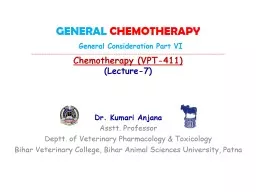/


General Consideration Part VI ID: 912215
Download Presentation The PPT/PDF document "GENERAL CHEMOTHERAPY" is the property of its rightful owner. Permission is granted to download and print the materials on this web site for personal, non-commercial use only, and to display it on your personal computer provided you do not modify the materials and that you retain all copyright notices contained in the materials. By downloading content from our website, you accept the terms of this agreement.
Slide1
GENERAL CHEMOTHERAPY General Consideration Part VI ……………………………………………………………………………………………………………………………………………………………………………………………………………………………………………Chemotherapy (VPT-411)(Lecture-7)
Dr. Kumari AnjanaAsstt. ProfessorDeptt. of Veterinary Pharmacology & ToxicologyBihar Veterinary College, Bihar Animal Sciences University, Patna
Slide2Content of the chapterCombined use of AntimicrobialsProphylactic use of AntimicrobialsFailure of Antimicrobials therapy
Slide3Combined use of AntimicrobialsJawetz's law on antimicrobial combination To achieve additive or synergistic effects: The rules regarding combination are: Bacteriostatic + Bacteriostatic = Additive/sometimes synergistic Bactericidal + Bactericidal =
Additive Bactericidal + Bacteriostatic = Generally antagonisticSynergistic combinations are used in full doses of individual drugs for achieving the goal.
Slide4Synergism Synergism can be defined as the positive interaction of two or more agents so that their combined effect is significantly greater than the expected sum of their individual effects (1 + 1 = 3).
Slide5Antagonism Antagonism is a negative interaction between two drugs; the combined effect of their combination is significantly less than the sum of the respective effect when tested separately (1+1=1).
Slide6Additive Additivity assumes that the result observed with more than one drug should be the sum of the separate effects of the drug being tested if those drugs do not interact with one another (1+1=2).
Slide7To broaden the spectrum of antibacterial activity: It is necessary in the treatment of mixed infection and in severe undiagnosed bacterial infections. Combination should not be the substitute of accurate diagnosis.
Slide8To curb the development of drug resistance: This is very important for the treatment of diseases where the organism is notorious for developing drug resistance and for chronic infections requiring prolonged antimicrobial therapy.To decrease the intensity of toxic effects: Drugs having low therapeutic index when used in their full doses precipitate toxicity. If such a drug is combined with another synergistic drug in reduced doses, it’s toxicity can be reduced. When amphotericin B + Flucytosine - cryptococcal meninnitis, A shorter course of treatment is needed than when amphotericin B is used alone.
Slide9Disadvantages of Combination of AMAsIncreased chance of development of variety toxicity.Improper combination results in increase in intensity of toxicity of a drug by another.Promotion of development of resistance or increase in nephrotoxicity (Gentamicin + cephaloridine).The chances of superinfections are increased.Generate a causal rather than rational view in diagnosis of infectious diseases or selection of AMA.Increase the cost of therapy.
Slide10ChemoprophylaxisIt is the use of an AMA to prevent the setting in of an infection in the body or to combat a contacted infection before its final clinical manifestation.It reduces the number of the viable microbe below the critical level; thus preventing infection.
Slide11The chemoprophylaxis may be done against specific organisms (generally highly satisfactory e.g. Tuberculosis in man with isoniazid.).It is also used for prevention of infection in some high risk situations e.g. urinary tract catheterization may be satisfactory but it is highly unsatisfactory and condemnable even hazardous if it is done for prevention of infection in general.
Slide12Misuses of AMAsTreatment of untreatable diseases: Use of antibiotics in viral diseases.Improper dosage: Antibiotics should be administered at adequate therapeutic doses will not suppress the bacteria, and at the same time may precipitate development of resistant population. Administration of higher doses can cause toxicity to the host.Superinfections: Use of oral antimicrobial therapy, especially the broad-spectrum antibiotics, suppresses the normal ruminal or intestinal microflora leading to development of enteric infections by the invading pathogenic microbe.
Slide13Inhibition of starter bacteria: Use of antibiotics in diary animals results in excretion of significant levels of the antibiotics through milk, which may suppress the starter bacteria.Antibiotics as growth promoters: Use of antibiotic-growth promoters in feed-lot animals before slaughter without observing withdrawal specifications ay pose public health hazard.
Slide14Applications of antibiotics in surgical wounds without proper drainage: Use of antibiotics to prevent bacterial infections, without removal of necrotic tissue debris or providing proper drainage for the purulent exudates, results in markedly lowered antibacterial potency of the antibiotics.
Slide15Failure of AMA TherapyWhen a real or apparent failure of the antimicrobial regimen occurs, the diagnosis and therapy should be reviewed. One of the following causes will usually be identified. Improper selection of drug, dose, route or duration of treatment.Treatment begun too late. Failure to take necessary adjuvant measures, e.g. drainage of abscesses, empyema, etc.; removal of renal stones, other foreign bodies or infected gall bladder, adjustment of proper urinary pH in case of urinary tract infection; cavity closure; control of diabetes, etc.
Slide16Poor host defence—as in leukaemias, neutropenia and other causes, especially if a bacteriostatic AMA is used. Infecting organism present behind barriers, such as vegetation on heart valves (SABE), inside the eyeball, blood brain-barrier.Trying to treat untreatable (viral) infections or other causes of fever (malignancy, collagen diseases). Presence of dormant or altered organisms (the persisters) which later give rise to a relapse.
Slide17Thank You